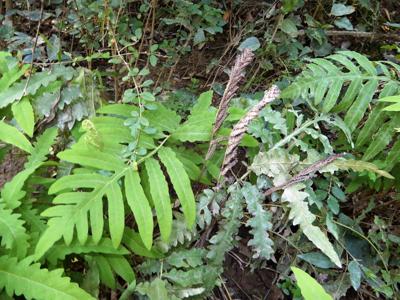
See if you can correctly identify this week’s mystery plant. [Answer: “Sensitive fern,” Onoclea sensibilis]
Are plants wimps?
There they are, growing with their little leaves, their roots in the ground, the little delicate flowers smiling up at the sun…and being eaten, trampled on, mowed down, dug up, burned, sprayed with herbicides, hardly ever putting up a fight. Some of those little plants out there, seems like if you just look at them hard enough, they let their petals fall off. Some others are afraid to have their leaves touched, and will roll or fold them up, to stay safe. And all those garden plants: so demanding, and always wanting something. Like water.
Of course this is all silly. Plants tend to be some of the most resilient organisms on our planet, and have evolved an incredible number of ways to deal with the difficulties of growing and producing a new crop of seeds. All of this means that there are no “sissy” plants.
In keeping with this theme, I present to you a native fern, one which is widespread across the eastern half of the United States, and much of eastern Canada. This is a plant that is a tough guy. It grows in places that might seem a bit scary: deep swampy bottomlands and ditches, where there are snakes, ticks, and wild hogs, for starters. The plants are deeply rooted in wet muck, and they can survive dry periods. Nothing seems to want to chew their leaves. They are survivors. Tough guys.
In the spring, this species will produce a shock of very handsome, bright green fronds. You can start seeing them now. Each frond is prominently divided into a number of divisions, or “pinnae”, but not divided all the way down to the midrib of the frond. The fronds are smooth along their margins, and usually opposite, that is, two arising from the same point off the midrib. But what about the spores? Don’t ferns reproduce by spores?
Well, yes. Those pretty green fronds coming up now are sterile, having nothing to do with reproduction. Later in the spring, a new set of fertile fronds will be produced, sticking up in the same clump, and looking nothing like the sterile fronds. These fertile fronds will have their pinnae wrapped individually into hard, bead-like structures, and the spores will be produced inside. These fertile fronds with the bead-like structures are called “sporophylls”. In the image provided here, you can see a nice green sterile frond on the left, with last year’s sporophylls on the right. This year’s haven’t come up yet.
So, yes, this is what we would call a real tough-guy fern, able to take of itself through hottest, muggiest summers, not caring a whit for all those mosquitoes in the swamp, and just looking good all season long.
But wait! Just as soon as fall comes, this plant starts getting a little bit worried about the coming cool weather, and when the first frost cones, even a very light one, all the fronds will die! Maybe it’s not so tough. Maybe it should get a sweater.
©JohnNelson2024.
John Nelson is the curator of the A. C. Moore Herbarium at the University of South Carolina, in the Department of Biological Sciences, Columbia SC 29208. As a public service, the Herbarium offers free plant identifications. For more information, visit www.herbarium.org or call (803) 777-8196, or email nelson@sc.edu.





